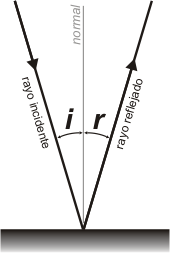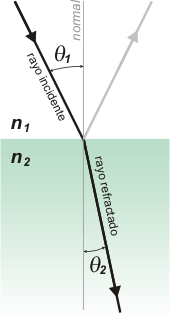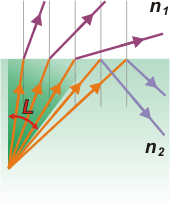 |
NO ME SALEN
EJERCICIOS RESUELTOS DE FÍSICA Y BIOFÍSICA
Ray optics
|
|

|
REFLECTION AND REFRACTION
Reflection
|
|
When a beam of light collides with a flat surface a part of the beam rebounds, and a part is absorbed. The smoother and more polished a surface is, the more orderly the fashion in which they rebound (in the sense that the parts of the ray which travel together continue travelling together after they rebound).
The surfaces in which the fractions of light which rebounds is maximum are called mirrors.
To understand the laws of reflection it results very practicle to use a fine beam, that is to say, a ray. The angle in which it collides with the reflecting surface, i, (measures in respect to an imaginary line normal to the surface) is equal to the angle with which it rebounds, r. |

|
| |
i = r |
|
|
|
The reflected beam is not as bright as the colliding beam. Part of the light was absorbed by the surface upon the beams collision with the surface. |
Also: Both rays and the normal line are found on the same plane.
During reflection an important amount of light is lost (its absorbed or disperesed). The best mirrors reflect 95% of incoming light, while normal mirrors reflect 80% to 85% of incoming light.
Refraction
When a beam of light passes through one medium to another, crossing through a smooth uniform surface seperating both mediums (for example water when it is still), a curious phenomenon called refraction occurs: the light deviates as it passes through the seperating surface. |
|
|
The passage of rays is governed by Snells Law, so called in honor of Willebrord Snell van Royen (Leiden, 1580-1626), also known as Snellius, a Dutch astronomer and mathematician.
n1 and n2 being the refractive index of the material through which the light travels, the following holds true: |

|
| |
n1 . sen Θ1 = n2 . sen Θ2 |
|
where Θ1 and Θ2 are the angles which are formed by the colliding and refracted ray in regards to the normal line on the seperating surface. If the second medium posesses a greater optical density (physics term), n1 < n2, then the ray is refracted closer in regards to the normal line. However, if the second medium is less optically dense, the ray is reflacted further from the normal line.
The diagram on the sidebar could represent air (up) and water (bottom). |
|
|
|
Total Internal Reflection
An immediate consequence of Snells Law is total internal reflection. If light is passing from an optically dense material to one that is less so, the refracted ray deviates from the normal line (that is, the angle of refraction is greater than the angle of collision), there shall exist an angle of collision such that the angle of refraccion will be 90 degrees, that is to say, the ray will skim the surface. |
|
|
This angle is called the critical angle, L, because the refracted angle cannot be refracted further from the normal (it would re-enter the first medium). In fact, this is what occurs if the angle of collision is superior to the critical angle... the ray reaches the seperating medium and acts as if it was reflected back into the originating medium...but it's not.
This forced reflection, contrary to reflections in mirrored surfaces, reflects 100% of incoming light, and that is why it is called total internal reflection. |

|
|
|
|
The phenomenon of total internal reflection has many important practical applications. The primary motive is that energy is not lost upon a ray being refracted and and dozens, hundreds, or thousands of refractions can be programmed without diminishing luminous energy. |
|
|
Optic fibers, for example, make use of the total internal reflection phenomena. It deals with a plastic polymer, sometimes a glass, or any other appropriate transparent, flexible material, through which a beam of light travels. When a beam touches the fibers wall it collides with an angle superior to that of the critical angle, and thus, it is refracted back into the fiber. The length of the fiber does not matter much, nor does the amount of times the light is refracted. All light injected into the fiber may be recollected at the other end.
For long distance communication, fiber optic cable has displaced digital cable.
Other classic examples are binoculars, remotely commanded cameras for endoscopy (medicinal) , etc. |

|
|
|
|
|
|
|
| IMPORTANT GOSSIP |
|
|
- Fotographic lenses and other optic artifacts posess antireflective films. In general they deal with extremely thin layers of inorganic salts or polymers with extremely low refractive indices, close to that of air.
- Astronomic mirrors (the best built mirrors) utilize deposited silver or vaporized aluminum in a vacuum.
- The refractive index of a medium depends not only on the properties of a medium but also on the longitud of the light waveform which is passing through it. That is to say, the color. Each color has -for each medium- has a slightly different refractive index. The most famous among them: the rainbow.
|
|
|
 |
| TRICKY QUESTIONS |
|
- What are mirages which are seen over desert sands due to?
- What are the mirages on roadway pavement due to?
|
|
| |
| Translated by Nelson Bermudez-Bassett. Some Rights Reserved. Not allowed to be copied without naming either the author or this source material. Last updated apr-12. Buenos Aires, Argentina. |
|
|
 |
 |
|
|
|

